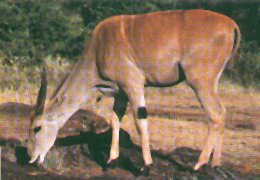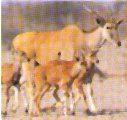
Eland

Order: Artiodactyla Family: Bovidae Genus & Species: Taurotragus oryx
Occurring in Africa, from southern Ethiopa, southern Sudan, Zaire, Angola and south to South Africa. Despite its massive bulk, the eland is an excellent jumper and can clear fences as high as 1.5m. It is also a swift runner, reaching speeds of up to 70km/h.
| Habitat A wide ranging nomad due to its choice of food, the eland rarely remains in one area for long. It browses in pastures throughout Africa's rolling grasslands but is also found in savannah woodlands and the harsh, thorny scrub of the Namib and Kalahari deserts. It even ventures to heights of up to 5,000m, such as the lower slopes of Mount Kilimanjaro in Kenya. The female is found in herds and prefers open country, while the male is more solitary and stays relatively close to woodland cover. |
 |
| The dry season forces the eland to roam more widely than usual to locate
its elusive food and, despite adaptations to cope with drought, it may retreat from the
plains into woodlands to feed on tree foliage. |
 |
Behaviour A typical eland herd would consist of around 25 females and a few breeding males. Herd composition is fluid and the only strong social bond is that existing between mother and young. The herd remains together during the rainy season, although it may disperse in the dry months to reduce competition for scarce food. |
| During the hottest months, the eland rests in shade during the day and
feeds at night. The animal survives for days without water by eating plants for
moisture and excreting concentrated urine. |
Feeding The eland feeds on high-protein vegetation rather than the tougher savannah grasses favoured by grazing animals. It prefers small herbaceous plants and fruits and also roots and tubers which it digs up with its hoofs. It gathers food with its tongue before snipping it off with its sharp incisors. |
 |
| When drought turns the grassland into dry, dusty plains, the eland
depends on woodland vegetation. It uses its robust horns to snap off tree branches
in order to browse on the leaves, particularly when bushfires have destroyed low-level
plants. It also readily eats acacia seedpods. Like cattle and deer, the eland has a multi-chambered stomach, enabling it to extract the most nutrients from tough plants. |
 |
Breeding In most parts of its range the eland breeds at any time of year. Having sought out a wandering herd of females, a male clashes with rivals as he attempts to win as many mates as possible. Often a male may be so impressively large that challengers give way without fighting. The female gives birth after a nine month gestation period. |
| The newborn weighs up to 36kg. Nursed on its mother's rich milk, it gains weight rapidly. At first the calf remains concealed among low grasses or bushes, only stirring at the approach of its mother, but within two weeks it is strong enough to join the mother's herd. Weaned at about five months, growing calves form distinct nursery herds, which may contain their mothers but no other adults. |